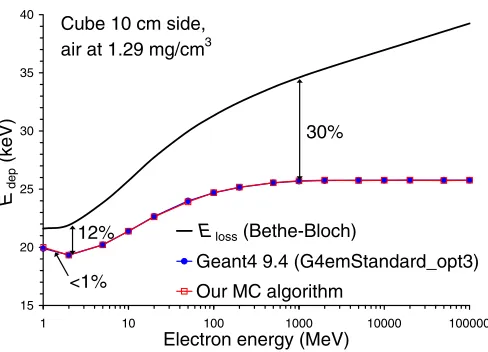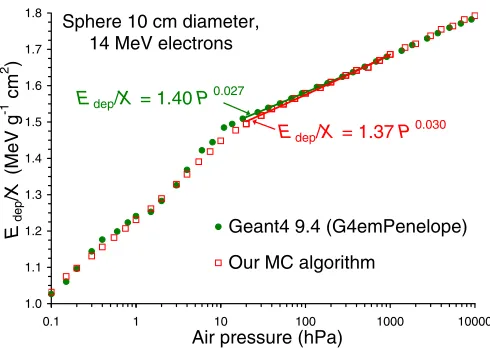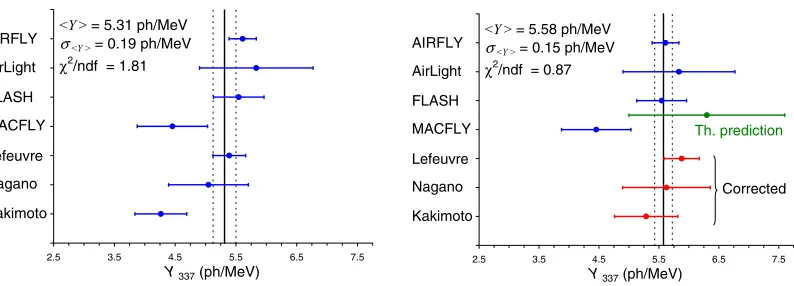C
Owned by the authors, published by EDP Sciences, 2013
On the energy deposition by electrons in air and the accurate
determination of the air-fluorescence yield
J. Rosado
a, P. Gallego, D. García-Pinto, F. Blanco and F. Arqueros
Departamento de Física Atómica, Molecular y Nuclear, Facultad de Ciencias Físicas, Universidad Complutense de Madrid, E-28040, Spain
Abstract. The uncertainty in the absolute value of the air-fluorescence yield still puts a severe limit on the accuracy in the primary energy of ultra-high-energy cosmic rays. The precise measurement of this parameter in laboratory is in turn conditioned by a careful evaluation of the energy deposited in the experimental collision chamber. In this work we discuss on the calculation of the energy deposition and its accuracy. Results from an upgraded Monte Carlo algorithm that we have developed are compared with those obtained using Geant4, showing excellent agreement. These updated calculations of energy deposition are used to apply some corrections to the available measurements of the absolute fluorescence yield, allowing us to obtain a reliable world average of this important parameter.
1. INTRODUCTION
The fluorescence technique for detection of extensive air showers has been proved to be very fruitful. It is based on the measurement of the faint fluorescence radiation of molecular nitrogen in the
∼300−400 nm spectral range induced by charged particles (mostly electrons) of a shower. By means of imaging telescopes, the longitudinal profile of the shower is recorded allowing its geometrical reconstruction. In addition, it provides a nearly calorimetric measure of the energy of the primary particle by means of the air-fluorescence yield Y, that is, the number of photons per unit deposited energy. This key parameter is a function of wavelength and depends on the atmospheric parameters, i.e., pressure, temperature and air composition. Nonetheless the energy scale of fluorescence telescopes is mainly determined by its absolute value, usually given at standard atmospheric conditions (e.g., dry air at 1013 hPa and 293 ˙K) and for the most intense band of the spectrum, located at 337˙nm.
The air-fluorescence yield is measured in dedicated experiments in laboratory using electron beams to excite air at known conditions in a collision chamber. The induced fluorescence is registered by an appropriate optical system. Several experiments use electrons from a 90Sr-90Y radioactive source (average energy around 1 MeV), whereas other experiments use beams from accelerators or electron guns (energies ranging from keV to GeV). It has been shown that the fluorescence yield is nearly independent of electron energy [1–3], which is the underlying principle of a calorimetric determination of the primary energy of extensive air showers. In fact, it is also expected to be independent of the type of incident particle, since both fluorescence emission and energy deposition are governed by low-energy secondary electrons produced in ionization processes.
An accurate experimental determination of the absolute air-fluorescence yield requires an end-to-end calibration of the optical system as well as a careful Monte Carlo (MC) evaluation of the energy deposited in the field of view. In this work we discuss on the calculation of the energy deposition and
ae-mail:jaime_ros@fis.ucm.es
Cube 10 cm side, air at 1.29 mg/cm3
15 20 25 30 35 40
1 10 100 1000 10000 100000
Electron energy (MeV) Edep
(keV)
Geant4 9.4 (G4emStandard_opt3)
Our MC algorithm Eloss (Bethe-Bloch)
<1% 12%
30%
Figure 1. Comparison of results of electron energy deposition from our upgraded MC simulation and Geant4 for a cube 10 cm side filled with air at 1.29 mg/cm3. An excellent agreement (<1%) is observed in the wide energy
range from 1 MeV to 100 GeV. The energy loss given by the Bethe-Bloch formula is also shown to illustrate the contribution of escapingrays.
its impact on the determination of the absolute air-fluorescence yield in dedicated experiments. Results of energy deposition from an upgraded MC algorithm that we have developed are compared with those obtained using Geant4. Finally, corrections previously proposed in [4–6] to some fluorescence-yield measurements have been updated according to these calculations, and a reliable world average of the absolute air-fluorescence yield is presented.
2. CALCULATION OF ENERGY DEPOSITION
Collision stopping power is accurately described by the Bethe-Bloch theory, reference data being tabulated in [7] for a number of materials including air. However, for a correct determination of the energy deposited in a finite air volume, the fraction of energy transferred to secondary radiation escaping this volume has to be evaluated. In particular, high-energy secondary electrons (rays) have large ranges. For instance, 100 keV electrons can travel 14 cm in air at atmospheric pressure before being stopped. Althoughrays are barely produced, they carry a significant fraction of the energy lost by the primary particle. This effect causes the energy deposition to be lower than the total energy loss by ∼8% for incident electrons of 1 MeV and by more than 30% for GeV electrons at usual experimental conditions (i.e., atmospheric pressure and a cm-sized collision chamber). This is illustrated in figure1, where MC calculations of the energy depositionEdepin a 10 cm cube as a function of electron energy are plotted together with the Bethe-Bloch energy loss.
In addition, other features related to the propagation of electrons through the experimental collision chamber have minor effects on the actual energy deposition. Firstly, stopping power varies along the trajectories of electrons as they lose energy gradually. In the second place, scattering due to both elastic and inelastic collisions affects the average path length of electrons inside the considered volume, contributing to either a rise or a reduction of the energy deposition depending on geometry.
Our MC
1 10 100 1000 10000
0 2 4 6 8 10 12 14 16 18 20 Track length (cm)
Frequency
Events: 10000 Mean: 9.94 cm RMS: 0.26 cm
Geant4, standard
1 10 100 1000 10000
0 2 4 6 8 10 12 14 16 18 20 Track length (cm)
Events: 10000 Mean: 10.02 cm RMS: 0.17 cm
Geant4, PENELOPE
1 10 100 1000 10000
0 2 4 6 8 10 12 14 16 18 20 Track length (cm)
Events: 10000 Mean: 10.01 cm RMS: 0.14 cm
Figure 2. Track lengths of 1 MeV electrons going through a 10 cm sphere (air at atmospheric pressure). From left to right, histograms are obtained using our MC algorithm, Geant4 with the standard physics list and Geant4 with the low-energy PENELOPE extension.
for the correctness and consistency of results on energy deposition, allowing estimation of uncertainties. This is mandatory to achieve high precision level (5%) in the absolute fluorescence yield.
3. COMPARISON OF MONTE CARLO SIMULATIONS
A series of comparisons between our MC algorithm and Geant4 has been reported in previous works [4–6], showing general agreement. However, non-negligible discrepancies were found and they have been being investigated. As a result of these studies, several improvements have been made in our MC algorithm:
1. Corrections for the density effect in molecular cross sections, only noticeable at very high energy, have been reviewed and now are applied to the cross section for K-shell ionization as well (see [10] for details).
2. The energy distribution of secondary electrons has been modified to better reproduce the end tail ofrays given by Möller scattering.
3. Angular-differential cross sections (both elastic and inelastic) have been corrected for some relativistic effects.
Updated results from our MC algorithm are presented here and compared with results from Geant4. In Figure 1, a comparison for the average energy deposition per electron in a cube of 10 cm side filled with air at 1.29 g/cm3 (1013 hPa and 273 K) is shown. The geometry was defined such that electrons crossed the cube along an axis going through the center of opposite faces. For this comparison, the standard physics list G4emStandard_opt3 of Geant4 version 9.4, including multiple scattering, ionization, bremsstrahlung and emission of both X rays and Auger electrons, was used. An excellent agreement (<1%) holds between both simulations in the wide energy range from 1 MeV to 100 GeV. Different geometries and other physics lists of Geant4 have been tested, always showing excellent agreement.
In [6], we reported some minor disagreement (∼2%) between our MC algorithm and Geant4. They are mainly attributed to the inaccuracies in the energy distribution of secondaries in earlier versions of our code (improvement 2). The corrections in the angular-differential cross sections (improvement 3) turned out to be appreciable only at low energy (1 MeV), since high-energy electrons follow almost rectilinear trajectories at those conditions. The latter corrections also contribute to a better agreement between both simulations.
Edep/X = 1.40 P 0.027
Edep/X = 1.37 P 0.030
1.0 1.1 1.2 1.3 1.4 1.5 1.6 1.7 1.8
0.1 1 10 100 1000 10000
Air pressure (hPa) Edep
/
X
(MeV g
-1 cm 2 )
Geant4 9.4 (G4emPenelope)
Our MC algorithm Sphere 10 cm diameter,
14 MeV electrons
Figure 3. Comparison between our MC algorithm and Geant4 for the pressure dependence of the energy deposition per unit mass thickness of air for 14 MeV electrons crossing a 10 cm diameter sphere. Both simulations predict a power law with a marked change of slope at around 10 hPa. Best fits of data in the 15−1000 hPa range are also shown.
extension (G4emPenelope library). Notice that data from our MC algorithm are more spread and its mean value is slightly lower than the predictions from both Geant4 simulations. These discrepancies could be due to the approximation of multiple scattering employed by Geant4 and are under study.
2.5 3.5 4.5 5.5 6.5 7.5
Y337 (ph/MeV) Kakimoto
Nagano Lefeuvre MACFLY FLASH AirLight
= 5.31 ph/MeV
σ = 0.19 ph/MeV
χ2
/ndf = 1.81 AIRFLY
2.5 3.5 4.5 5.5 6.5 7.5 Y337 (ph/MeV)
Kakimoto Nagano Lefeuvre MACFLY FLASH AirLight
= 5.58 ph/MeV
σ = 0.15 ph/MeV χ2
/ndf = 0.87 AIRFLY
Th. prediction
Corrected
Figure 4. Effect of our corrections on the available fluorescence-yield measurements normalized to common conditions (1013 hPa, 293 K and 337 nm band). Original results are on the left and corrected ones (when applicable) are on the right, showing better compatibility. Vertical lines represent the position of the sample weighted average Yand its standard errorY. The theoretical fluorescence-yield value predicted by our MC simulation is also shown for comparison.
experiment have also been investigated, finding some discrepancies between the simulations that are still unclear.
Taking into consideration that our MC algorithm and Geant4 use different approaches for particle transport and are based on nearly independent molecular data, this consistency of results suggests that a high-precision level in the energy deposition is reached. On the other hand, this precision is limited by the accuracy in reference data of the Bethe-Bloch stopping power, which is estimated to be about 1% in the energy range of interest [7]. In view of that, we estimate a conservative total uncertainty of 2% in the above calculations of energy deposition.
4. IMPACT ON THE FLUORESCENCE YIELD
Several absolute measurements of the air-fluorescence yield are available in the literature. In recent experiments [12–14, 16], energy deposition was carefully evaluated by means of detailed Geant4 or EGS4 simulations. However, the authors of other well-known experiments [17–19] determined it from the Bethe-Bloch formula ignoring the effect of the escaping secondary radiation, which can cause large systematic errors, as discussed above.
In previous works [4–6], we proposed corrections to the energy deposition calculated in some of these experiments and the fluorescence-yield values were re-normalized correspondingly (the experimental fluorescence intensities were unchanged). As a consequence of these corrections, a very consistent sample of fluorescence-yield values was obtained, allowing us to calculate a reliable world average of this important parameter. The above-mentioned upgrades in our MC algorithm slightly affect this average. Next, updated results from this analysis are presented.
Figure 4 shows a comparison of the available experimental data of the absolute fluorescence yield normalized to common conditions, i.e., 337 nm band, dry air at 1013 hPa and 293 K.1 Original fluorescence yields (after being normalized to these reference conditions) are plotted on the left. In the right plot, results from experiments that did not evaluate the energy deposition by simulation are corrected according to our calculations. Experimental uncertainties are not modified in any case,
and it has been assumed that different measurements of a same experiment (only mean values are shown in4) are fully correlated but no correlation exists between experiments. The sample includes the very precise measurement recently reported by the AIRFLY Collaboration [16], that use Geant4 to evaluate the energy deposition assuming an error contribution of 2% to the total uncertainty of 4%.
Our corrections increase the fluorescence yields of [17–19] by 9−24%, leading to an improved compatibility of results. Notice that the2 statistic normalized by the number of degrees of freedom is lowered from 1.81 to 0.87 after our corrections. The sample average Y =5.58 ph/MeV is calculated using as weights the reciprocals of the squared experimental uncertainties. Somewhat different averages ranging from 5.46 ph/MeV to 5.68 ph/MeV are derived from plausible variations on the statistical analysis (e.g., treatment of outliers, weights and correlations) and on our corrections (e.g., geometrical implementation details in our simulations). The standard error of the weighted mean Y=0.15 ph/MeV (2.6%) is determined from the quoted uncertainties following the usual procedure. However, this low uncertainty seems to us to be unrealistic, because some experiments did not include any error contribution from the evaluation of the energy deposition, which we estimate to be 2% at least for Geant4 and our MC algorithm. In addition, there are still some discrepancies between simulations to be elucidated, as pointed out above. Taking into account all these considerations, we propose an average fluorescence-yield value of 5.58 ph/MeV and a conservative uncertainty estimate of 4%, i.e., as low as the smallest uncertainty of the sample corresponding to the AIRFLY measurement. Indeed, it can be understood from the present analysis that this average and the AIRFLY measurement (5.61 ph/MeV) are complementary results showing high reliability.
Our MC algorithm is able to simulate both the energy deposition and the fluorescence emission [1,10], which in combination with experimental quenching data from [11] also allows us to give a prediction of the absolute fluorescence yield of 6.3±1.3 ph/MeV, in agreement with experimental data (Fig.4, right plot). Although we estimate a large uncertainty in this value due to the uncertainties in the many molecular parameters involved in the calculation, the agreement with the experimental results provides a valuable theoretical support to these measurements.
5. CONCLUSIONS
We show that effects of secondary radiation escaping the collision chamber are very relevant for a correct determination of the energy deposition in experiments dedicated to measure the air-fluorescence yield. Assuming the Bethe-Bloch stopping power instead of computing the energy deposition by simulation may lead to large systematic errors in the fluorescence yield.
New results of energy deposition from an upgraded MC algorithm that we have developed are presented here, showing an excellent agreement with Geant4 for electrons with energies in the wide 1 MeV − 100 GeV range. From the present comparison, we conclude that these calculations have a precision level of 2%. On the other hand, small differences in the simulated electron trajectories are found, with possible implications at lower energy or in experiments with strong dependencies on geometrical factors.
Our updated calculations of energy deposition have been used to correct experimental fluorescence-yield values reported by experiments that did not evaluate the energy deposition by simulation. These corrections improve significantly the compatibility of the available measurements of the absolute air-fluorescence yield. As a result of this analysis, we present a reliable average of 5.58 ph/MeV with an estimated uncertainty of 4%. In addition, experimental data are shown to be consistent with a theoretical prediction of the absolute fluorescence yield that we obtained by means of our MC simulation.
References
[1] F. Arqueros et al., New J. Phys. 11 (2009) 065011
[2] J.W. Belz et al. [FLASH Collaboration], Astropart. Phys. 25 (2006) 57 [3] M. Ave et al. [AIRFLY Collaboration] Nucl. Instr. and Meth. A 597 (2008) 46 [4] J. Rosado, F. Blanco and F. Arqueros, Astropart. Phys. 34 (2010) 164
[5] J. Rosado, F. Blanco and F. Arqueros, AIP Conf. Proc. 1367 (2011) 34 [6] J. Rosado et al., 32nd International Cosmic Ray Conference (Beijing, 2011)
[7] A. Allisy et al., Stopping Powers for Electrons and Positrons (ICRU Report No. 37, 1984) [8] S. Agostinelli et al., Nucl. Instrum. Meth. A 506 (2003) 250
[9] W.R. Nelson, H Hiragrama and D.W.O. Rogers, The EGS4 Code System (Stanford Linear Accelerator Center, SLAC-265, 1985)
[10] J. Rosado, PhD Thesis (2011)
[11] M. Ave et al. [AIRFLY Collaboration], Astropart. Phys. 28 (2007) 41 [12] P. Colin et al. [MACFLY Collaboration], Astropart. Phys. 27 (2007) 317 [13] R. Abbasi et al. [FLASH Collaboration], Astropart. Phys. 29 (2008) 77 [14] T. Waldenmaier et al., Astropart. Phys. 29 (2008) 205
[15] T. Waldenmaier et al., 8th Air-Fluorescence Workshop (Karlsruhe, 2011)
[16] M. Bohacova et al. [AIRFLY Collaboration], 8th Air-Fluorescence Workshop (Karlsruhe, 2011) [17] F. Kakimoto et al., Nucl. Instrum. Meth. A 372 (1996) 205
[18] M. Nagano et al., Astropart. Phys. 22 (2004) 235



